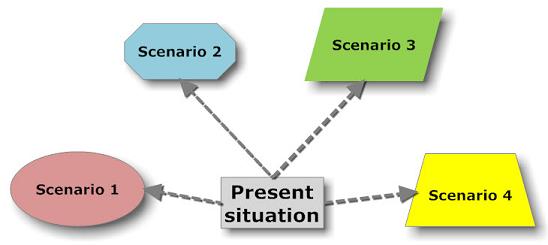Formal scenario planning emerged during the Second World War, when it was used as a part of military strategy as countries prepared themselves for different contingencies. Since then, the use of scenario planning has become increasingly popular.
Scenarios are tools for ordering one’s perception about alternative future environment in which today’s decision might be framed. In practice, scenarios resemble a set of stories, written or spoken, built around carefully constructed plots. These stories can express multiple perspectives on complex events, scenarios give meaning to these events. Scenarios are powerful planning tools precisely because the future is unpredictable. Unlike traditional forecasting or market research, scenarios present alternative images instead of extrapolating current trends from the present.
Scenarios also embrace qualitative perspectives and the potential for sharp discontinuities that econometric models exclude. Consequently, creating scenarios requires decision-makers to question their broadest assumptions about the way the world works so that they can foresee decisions that might be missed or denied.
Without an organization, scenarios provide a common vocabulary and an effective basis for communicating complex — sometimes paradoxical — conditions and options. Good scenarios are plausible and surprising, they have the power to break old stereotypes, and their creators assume ownership and put them to work. Using scenarios is rehearsing the future. By recognizing the warning signals, the threats and opportunities that is unfolding, one can avoid surprises, adapt and act effectively.
Scenarios allow discussions to be more uninhibited, help challenge established views and enable new ideas to be tested. Seeing reality from different perspectives reduces the risk of increasing commitment to failing strategies.
Decisions which have been pre-tested against a range of what may offer are more likely to stand the test of time, produce robust and resilient strategies, and create distinct competitive advantage. Ultimately, the result of scenario planning is not a more accurate picture of tomorrow but better thinking and an ongoing strategic conversation about the future.
To summarize,
Scenario planning enables firms to plan for the future by visualizing different ways in which the external environment may evolve in the future. The construction of a number of scenarios, each describing a possible future state, can help organizations deal with uncertainty more effectively. Scenario building stimulates creative thinking and helps identify major opportunities and threats in the future by taking into account various political, social, economic and technological factors. By contemplating a range of possible futures, better informed decisions can be taken and linkages between apparently unrelated factors identified.
Implementation of Scenario Planning
The basic premise behind scenario planning is that reacting in ad hoc fashion to external events is not desirable. Understanding long-term trends enables companies to prepare for different future scenarios. It also helps a company to identify the scenarios for which its strengths and competencies are particularly suited. At the same time, by identifying the scenarios for which it is least prepared, the company can invest in building the required competencies. In extreme cases, it can even divest businesses, which do not look promising in the long run.
A company wide involvement in scenario planning leads to better results in a firm. A cross-functional team is instituted for the identification and monitoring of issues. Employees are encouraged to participate by an incentive based process.
Steps involved in scenario planning;
- Identification of issues : understand the effects of external factors on business — technology driven, political, economic, competitive positioning.
- Classification of issues : support the issue identified with reports/propositions, determine the uncertainty and kind of impact of the issue.
- Analyzing and problem solving.
Short Case Study: Scenario Planning at Duke Energy
Duke Energy is one of the largest energy generators and marketers in United States, and has been suffering increasingly intense competition as that industry becomes more uncertain and complex. Demand for energy is strongly dependent upon the economic cycle, which itself is highly unpredictable. In addition, energy generation capacity must be planned at least five years in advance, is very costly to develop, and can sit idle for some time if forecasts are inaccurate. To cope with this uncertainty, Duke managers developed three possible future industry scenarios. In the first, demand slips; in the second, energy trading becomes dominated by Internet firms, rather than traditional marketers such as Duke; and in the third, demand grows, as does competition. For each scenario, managers identified about 20 signals that would indicate the scenario was developing in reality. Monitoring these signals pointed to the likelihood of the third scenario dominating the industry trends, and managers immediately began to make decisions that would maximize performance under that scenario, such as increasing capacity. Duke executives also realized that they could take some relatively simple and inexpensive actions that would enable them to hedge their bets, in case another scenario developed instead.
External Links:
